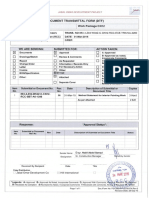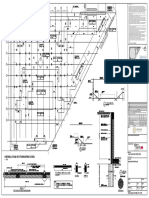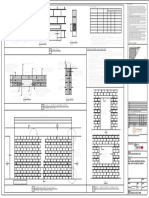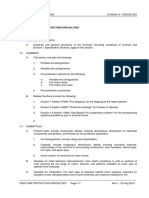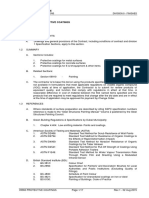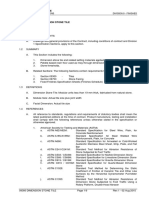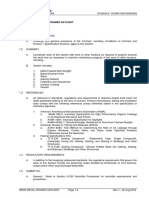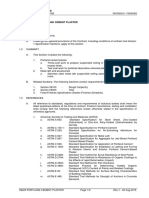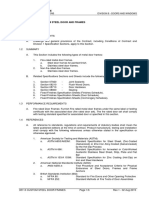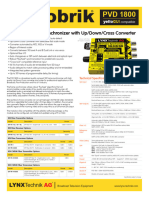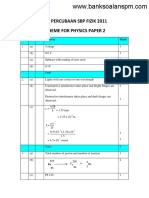Section 09910 Painting
Uploaded by
MØhãmmed ØwięsSection 09910 Painting
Uploaded by
MØhãmmed ØwięsENGINEERING OFFICE
GENERAL SPECIFICATIONS DIVISION 9 - FINISHES
SECTION 09910 - PAINTING
PART 1 - GENERAL
1.1 RELATED DOCUMENTS
A. Drawings and general provisions of the Contract, including conditions of contract and Division
1 Specification Sections, apply to this section.
1.2 SUMMARY
A. This Section includes surface preparation and field painting of exposed surfaces of the
following:
1. Walls and ceilings prepared with Portland cement plaster coats.
2. Steel or galvanized steel surfaces of metal fabrications specified to receive field finish
paining.
3. Wood surfaces specified to receive field-applied opaque finish painting.
B. Related Sections include the following:
1. Division 5 - Metal
2. Section 06400 - Architectural Woodwork
3. Section 09220 - Portland Cement Plaster
4. Section 09260 - Gypsum Board Assemblies
5. Section 09720 - Wall Coverings
6. Fixed Finishes Specification Sheets (Finishes Schedule)
1.3 REFERENCES
A. All reference to standards, regulations and requirements of statutory bodies shall mean the
latest published editions at the time of contract. Product manufacture, testing and installation
shall comply with the following references unless otherwise stated in the specification or
otherwise approved.
1. Green Building Regulations & Specifications by Dubai Municipality:
a. Chapter 4:404: Hazardous Materials – Paints & Coatings, for VOC content
2. American Society for Testing and Materials (ASTM):
a. ASTM D16: Standard Terminology for Paint , Related Coatings, Materials
and Applications
b. ASTM D2486: Standard Test methods for Scrub Resistance of Wall Paints
3. British Standards Institution (BSI):
a. BS 245: Specification for Mineral Solvents (White Spirit and Related
Hydrocarbon Solvents) for Paints and other Purposes
b. BS 381C: Colour Chart
c. BS 1336: Specification for Knotting
d. BS 4800: Schedule of Paint Colour
e. BS 7956: Specification for Primers for Woodwork
f. BS 6150: Painting of Buildings. Code of Practice
1.4 DEFINITIONS
A. General: Standard coating terms defined in ASTM D 16 apply to this Section.
1. Flat refers to a lustreless or matte finish with a gloss range below 15 when measured
at an 85-degree meter.
2. Eggshell refers to low-sheen finish with a gloss range between 20 and 35 when
measured at a 60-degree meter.
09910 PAINTING Page 1/13 Rev.1 - 02 Aug 2015
ENGINEERING OFFICE
GENERAL SPECIFICATIONS DIVISION 9 - FINISHES
3. Semi-gloss refers to medium-sheen finish with a gloss range between 35 and 70 when
measured at a 60-degree meter.
4. Full gloss refers to high-sheen finish with a gloss range more than 70 when measured
at a 60-degree meter.
1.5 SUBMITTALS
A. Product Data: For each paint system indicated. Include block fillers and primers.
1. Material List: An inclusive list of required coating materials. Indicate each material and
cross-reference specific coating, finish system, and application. Submit evidence that
paints proposed for use satisfy requirements for performance of paints as specified
hereafter. Identify each material by manufacturer’s catalogue number and general
classification.
2. Manufacturer’s Information: Manufacturer’s technical information, including label
analysis and instructions for handling, storing, and applying each coating material.
B. Samples for Initial Selection: For each type of finish-coat material indicated.
C. Samples for Verification: For each colour and material to be applied, with texture to simulate
actual conditions, on representative samples of the actual substrate.
1. Provide stepped Samples, defining each separate coat, including block fillers and
primers, Use representative colours when preparing samples for review. Resubmit until
required sheen, colour, and texture are achieved.
2. Provide a list of materials and applications for each coat of each sample. Label each
Sample for location and application.
3. Submit 3 samples on the following substrates for the Engineers review of colour and
texture only:
a. Painted Wood: 200mm square samples for each colour and material on
hardboard.
b. Stained or Natural Wood: 100 by 200mm samples of natural- or stained-wood
finish on representative surfaces.
c. Painted plaster board 300 x 300mm
D. Qualification Data, for the applicator:
1.6 QUALITY ASSURANCE
A. Quality System: Paints and Coatings must be accredited/certified from Dubai Central
Laboratories or any source approved by Dubai Municipality.
B. Furnish products and materials produced by manufacturer holding valid ISO 9001/9002
Quality System certificates.
C. Applicator Qualifications: A firm or individual experienced in applying paints and coatings
similar in material, design, and extent to those indicated for this Project, whose work has
resulted in applications with a record of successful in-service performance. Artisans: Only
skilled workmen shall be employed. A properly qualified foreman shall be constantly in
attendance on Site whilst the work is proceeding.
D. Source Limitations: Obtain primers for each coating system from the same manufacturer as
the finish coats.
E. Benchmark Samples (Mock-ups): Provide a full-coat benchmark finish sample for each type
of coating and substrate required. Comply with procedures specified in PDCA P5. Duplicate
finish of approved sample submittals.
1. After permanent lighting and other environmental services have been activated, the
Engineer will select room(s) or surface(s) to represent conditions for application of
each type of coating and substrate.
09910 PAINTING Page 2/13 Rev.1 - 02 Aug 2015
ENGINEERING OFFICE
GENERAL SPECIFICATIONS DIVISION 9 - FINISHES
a. After finishes are accepted, the Engineer will use the room or surface to
evaluate coating systems of a similar nature.
2. Final approval of colours will be from benchmark samples.
F. Manufacturers Qualifications: Paint materials shall be the products of paint and coating
manufacturers whose qualifications are as follows:
1. Manufacturers shall be reputable of multi-national scale in production and distribution
with capabilities to deliver paint materials quantities necessary for the project on due
time.
2. Manufacturers shall have evidence from scientific bodies that demonstrate their
participation and share in the development of paint industry generally and production of
new painting materials kinds.
3. Manufacturers shall have their own proprietary brand names that are well known
worldwide.
4. Manufacturers shall have minimum twenty-five (25) years of successful experience in
producing painting materials for use in prestigious projects worldwide of same standard
of quality as that intended for the Project.
5. Manufacturers shall be registered in the associations, councils, boards, federations or
other similar bodies of paint manufacturers in countries of origin and practice.
G. Performance of Paints: Paints shall be fit for purpose and manufactured specifically for the
applications indicated and uses intended, taking into account the type, nature, location, and
aesthetic and utility requirements of the Project.
1. Opacity: Paint shall cover or hide the substrate to the Engineers satisfaction.
2. Cleanability: Paint shall not absorb dirt and shall be capable of being washed or
scrubbed periodically, to the Engineer’s satisfaction, without adverse effect on its
attributes or appearance.
3. Scrub resistance wet and dry: Paint shall resist abrasion caused by scrubbing in
accordance with ASTM D 2486.
4. Adhesion: Paint shall adhere firmly to the substrate without peeling.
5. Exposure resistance: Paint shall resist yellowing.
6. Standards: Paints shall be manufactured BS 6150, to relevant US standards, or any
other international standard approved by the Engineer.
7. Colour Differentiation: The Contractor shall supply decorative colours to the references
that are scheduled or otherwise instructed by the Engineer and to conform to BS 4800
or BS 381C or other colour referencing systems only when specifically indicated on the
drawings or in the Specification.
1.7 DELIVERY, STORAGE, AND HANDLING
A. Deliver materials to Project site in manufacturers original, unopened packages and
containers bearing manufacturer’s name and label and the following information:
1. Manufacturer's name, initials or recognised trademark
2. Product name or title of material
3. Product description (generic classification or binder type)
4. Manufacturer’s stock number and date of manufacture
5. Contents by volume, for pigment and vehicle constituents
6. Thinning instructions
7. Application instructions
8. Colour name and number or RAL Colour reference (when specified alternatively)
9. VOC content
B. Containers not displaying the aforementioned information are not acceptable.
C. Store materials not in use in tightly covered containers in a well-ventilated area at a minimum
ambient temperature of 7°C (45°F). Maintain storage containers in a clean condition, free of
foreign materials and residue.
09910 PAINTING Page 3/13 Rev.1 - 02 Aug 2015
ENGINEERING OFFICE
GENERAL SPECIFICATIONS DIVISION 9 - FINISHES
1. Keep storage area neat and orderly. Remove oily rags and waste daily.
2. In stores within limits that may not cause change in viscosity of paint materials as
recommended in writing by manufacturers.
1.8 PROJECT CONDITIONS
A. Apply waterborne paints only when temperatures of surfaces to be painted and surrounding
air are between 10 and 32°C (50 and 90°F).
B. Apply solvent-thinned paints only when temperatures of surfaces to be painted and
surrounding air are between 7 and 35°C (45 and 95°F).
C. Do not apply paint in rain, fog, or mist; or when relative humidity exceeds 85 percent; or at
temperatures less than 3°C (37°F) above the dew point; or to damp or wet surfaces.
1.9 EXTRA MATERIALS
A. Furnish extra paint materials from the same production run as the materials applied and in
the quantities described below. Package with protective covering for storage and identify with
labels describing contents. Deliver extra materials to the Employer.
1. Quantity: Furnish the Employer with an additional 5 percent, but not less than 3.8 L or
1 case, as appropriate, of each material and colour applied.
PART 2 - PRODUCTS
2.1 PAINT MATERIALS, GENERAL
A. Material Compatibility: Provide block fillers, primers, and finish-coat materials that are
compatible with one another and with the substrates indicated under conditions of service
and application, as demonstrated by the manufacturer based on testing and field experience.
B. Material Quality: For each kind, type or application of paint material, provide best-quality and
highest-grade paint material in the full range of the approved manufacturer. For each paint
system specified or indicated, submit the written certification of the manufacturer attesting
that the proposed system is the highest quality system he produces for the application.
C. Provide painting materials that are factory formulated and recommended by the manufacturer
for application indicated.
D. Odour: Paints for repaired surfaces in occupied areas shall be odourless type paints such as
acrylic enamel paints.
E. Colours and Sheens: As selected by the Engineer from NCS full range, identified in Fixed
Finishes Specification Sheets (Finishes Schedule) and selected by the Engineer based on
submitted samples.
F. Date of Manufacture: At time of application, any paint material shall not be more than 4
months old from date of manufacture, unless shorter time period is stipulated by
manufacturer.
G. Preparatory Materials
1. Paint removers, abrasive papers and blocks, cleaning agents, etching solutions,
stopping, knotting, fillers and other commodities shall be of the types recommended by
the manufacturer of the coating to be applied.
2. White spirit shall comply with BS 245.
3. Knotting shall comply with BS 1336.
09910 PAINTING Page 4/13 Rev.1 - 02 Aug 2015
ENGINEERING OFFICE
GENERAL SPECIFICATIONS DIVISION 9 - FINISHES
4. Stopping and filler for woodwork shall be approved proprietary leadless, oil-based type
recommended for internal or external work as appropriate. Stopping for woodwork to
receive a clear finish shall be tinted to match with the surrounding woodwork.
5. Filler for plaster and rendering shall be an approved proprietary type.
Fillers and Putties: Types compatible with substrate and materials of priming and different
coatings of the coating system and recommended by the manufacture of the coating system
for the purpose.
H. Primer, Paints and Coatings
1. All brands of primers, paints and coatings shall be approved and shall comply with the
relevant BS where one exists.
2. Primers for plaster and rendering shall be alkali resistant.
3. Undercoats on wood and metal surfaces shall be of the drying-oil/alkyd resin binder
type pigmented with titanium dioxide and/or light fast coloured pigments.
4. Water thinned priming paints and undercoats shall only be used with the specific
approval of the Engineer and compliance with BS 7956 will need to be demonstrated in
order to obtain such approval.
5. Finish coats on wood and metal surfaces shall be of the drying-oil/alkyd resin binder
type pigmented with titanium dioxide and/or light fast, coloured pigments.
2.2 INTERIOR PRIMERS
A. Interior Portland Cement Plaster Primer: Factory-formulated latex-based primer for interior
application.
B. Interior Gypsum Board Primer: Factory-formulated latex-based primer for interior application.
C. Interior Wood Primer for Enamel Finishes: Factory-formulated alkyd or interior wood primer
compatible with specified finish coat.
D. Interior Ferrous-Metal Primer: Factory-formulated quick-drying rust-inhibitive lead-free,
polyurethane based metal primer.
E. Interior Zinc-Coated Metal Primer: Factory-formulated zinc-rich, lead-free galvanized metal
primer compatible with polyurethane-base-finish coat.
2.3 INTERIOR FINISH COATS
A. Acrylic Emulsion Paint: Emulsion paint for coating internal Portland cement plaster and
(gypsum) board surfaces shall be acrylic-copolymer based emulsion to produce a durable,
flexible and water-resistant coating suitable for repeated washing and scrubbing and of colour
retention and non-yellowing properties and high hiding and bonding to substrates abilities.
Percentage (%) of solids shall not be less than 35%. Only acrylic-copolymer shall be used in
solids (100% acrylic paint). The coating shall be of antimicrobial properties (shall not support
the growth of fungus and micro-organisms). The surface gloss shall be as indicated on
Finishes Schedule and as selected by the Engineer from samples submitted for different
available sheens. The coating system shall consist of two coats finish over one priming coat
as a minimum.
B. Polyurethane Based Paint: Provide the following finish system over steel and galvanized
steel:
1. Aliphatic Polyurethane Enamel, two pack acrylic resin based enamel cured with
aliphatic polyisocyanate applicable on steel primed with epoxy-based primers. Dry
enamel film shall exhibit excellent gloss and colour retention, durability, scratch and
abrasion resistance and chemical resistance. Comply with the following:
Binder: Acrylic/aliphatic polyisocyanate
Pigments: Rutile titanium dioxide and/or colour pigments and functional
extenders
09910 PAINTING Page 5/13 Rev.1 - 02 Aug 2015
ENGINEERING OFFICE
GENERAL SPECIFICATIONS DIVISION 9 - FINISHES
Appearance: Gloss, semi-gloss or matt as directed by the Engineer
Colour: As selected by the Engineer from manufacturer’s full range of
colours
% Solids: 51, by volume, minimum
Flash point: 21º C, maximum
Application: Airless spray, air spray or brush
Dry Film Thickness: 30 microns per coat, minimum
Thinners: As recommended by manufacturer
2.4 APPLICATION THICKNESS AND PAINT CHARACTERISTICS
A. General
1. All Paints and Coatings should not exceed the allowed limits of Volatile Organic
Compound (VOC) set by Dubai Green Building Regulations & Specifications.
Type A : Acrylic Copolymer Water based, alkali resistant Primer/sealer
PRIMER
(Internal)
Solids by Vol : 32±2%
Finish : Flat
Type B : Acrylic Copolymer Water based, high quality alkali resistant Primer/sealer
PRIMER(External)
Solids by Vol : 37±2%
Finish : Flat
Type C Putty Coat Water based, acrylic copolymer based putty/filler
(Internal)
Solids by Vol : 50±2%
Finish : Flat
Type D Emulsion Paint 100 % Acrylic based emulsion paint. Highly Washable Silk
(Internal) finish.
Solids by Vol 38±2%
VOC : 28-32 gms/l
Crack bridging ability Up to 1mm
Colour As instructed
Type E Textured High Build Acrylic copolymer based high-build texture paint.
(External)
Solids by Vol 62±2%
Finish As instructed
Type F Heat Reflective 100 % Acrylic based emulsion paint. Heat reflective
Washable Silk finish.
TOPCOAT
(External) Solids by Vol 39±2%
CO 2 Resistance R-Value 624 m
MV Resistance Sd Value 1.46 m
LW Resistance 99.9%
Colour As instructed
Finish : Silk
Type G Wood Primer (Internal Solvent based, Primer for wood
and External Woodwork)
Solids by Vol : 47±2%
Finish : Flat
09910 PAINTING Page 6/13 Rev.1 - 02 Aug 2015
ENGINEERING OFFICE
GENERAL SPECIFICATIONS DIVISION 9 - FINISHES
Type H Enamel Flat(Internal Alkyd based flat wood undercoat,
Woodwork)
Solids by Vol 47±2%
DFT/Coat 35 microns
Finish Matt
Colour As instructed
Type I Enamel Gloss (Internal Alkyd based gloss topcoat,
/External Woodwork)
Solids by Vol 38±2%
DFT/Coat 30 microns
Finish Gloss
Colour As instructed
Type J Acrylic Solvent Based Acrylic solvent based undercoat/topcoat
Paint (Internal/External) for
Road Marking
Solids by Vol 37±2%
DFT/Coat 60 microns
Colour As instructed
Type K Primer (Metal Work) Epoxy based Two Component Primer
Solids by Vol 50±2%
DFT/Coat 100 microns
Colour As instructed
Type L Undercoat (Metal Epoxy based Two component undercoat
Work)
Solids by Vol 82±2%
DFT/Coat 150 microns
Colour As instructed
Type M Topcoat (Metal Work) Epoxy based Two component Topcoat
Solids by Vol 50±2%
DFT/Coat 50 microns
Colour As instructed
Type N Topcoat (Metal Work) PU based Two component Topcoat
Solids by Vol 50±2%
DFT/Coat 50 microns
Colour As instructed
09910 PAINTING Page 7/13 Rev.1 - 02 Aug 2015
ENGINEERING OFFICE
GENERAL SPECIFICATIONS DIVISION 9 - FINISHES
2.5 COAT APPLICATIONS AND LOCATIONS
(i) Heat Reflective Pure Acrylic Surface Preparation as per Manufacturer’s
Masonry Paint recommendation
(Ref. Finishing Schedule) System:
st
1 Coat: Type-B
nd
2 Coat: Type-E
rd th
3 & 4 Coat: Type F
(ii) Acrylic Silk Emulsion Paint Surface Preparation as per Manufacturer’s
(Ref. Finishing Schedule) recommendation
(Internal) System:
st
1 Coat: Type-A
nd rd
2 & 3 Coat: Type-C
rd th
3 & 4 Coat: Type F
(iii) Woodwork Surface Preparation as per Manufacturer’s
(Internal) recommendation
System:
st
1 Coat: Type-G
nd
2 Coat: Type-E
rd th
3 & 4 Coat: Type-H or I
(iv) Timber Doors Surface Preparation as per Manufacturer’s
(Internal) recommendation
System:
st
1 Coat: Type-G
nd
2 Coat: Type-E
rd th
3 & 4 Coat: Type –H or I
(v) Timber Doors(External) Surface Preparation as per Manufacturer’s
recommendation
System:
st
1 Coat: Type-B
nd
2 Coat: Type-H
rd th
3 & 4 Coat: Type I
(vi) Pipework (Plastic) (Internal) Surface Preparation as per Manufacturer’s
recommendation
System:
st
1 Coat: Type-K
nd
2 Coat: Type-M
(vii) Pipework (Copper, steel) Surface Preparation as per Manufacturer’s
(Internal) recommendation
System:
st
1 Coat: Type-K
nd
2 Coat: Type-L
rd
3 Coat: Type M
(viii) Mild Steel, Aluminium, Metal Surface Preparation as per Manufacturer’s
Work recommendation
(Internal) System:
st
1 Coat: Type-K
nd
2 Coat: Type-L
rd
3 Coat: Type M
(ix) Mild Steel, Aluminium Metal Surface Preparation as per Manufacturer’s
Work(External) recommendation
System:
st
1 Coat: Type-K
nd
2 Coat: Type-L
rd
3 Coat: Type N
(x) Kerbstone Surface Preparation as per manufacturer’s
recommendation
System:
st nd
1 & 2 Coat: Type: Type-J
09910 PAINTING Page 8/13 Rev.1 - 02 Aug 2015
ENGINEERING OFFICE
GENERAL SPECIFICATIONS DIVISION 9 - FINISHES
PART 3 - EXECUTION
3.1 EXAMINATION
A. Examine substrates, areas, and conditions, with the Applicator present, for compliance with
requirements for paint application. Comply with procedures specified in referenced Standard
Specifications.
1. Proceed with paint application only after unsatisfactory conditions have been corrected
and surfaces receiving paint are thoroughly dry.
2. Start of painting will be construed as Applicators acceptance of surfaces and
conditions within a particular area.
B. Coordination of Work: Review other Sections in which primers are provided to ensure
compatibility of the total system for various substrates. On request, furnish information on
characteristics of finish materials to ensure use of compatible primers.
3.2 PREPARATION
A. General: Remove hardware and hardware accessories, plates, machined surfaces, lighting
fixtures, and similar items already installed that are not to be painted. If removal is impractical
or impossible because of size or weight of the item, provide surface-applied protection before
surface preparation and painting.
1. After completing painting operations in each space or area, reinstall items removed
using workers skilled in the trades involved.
2. Protection
a. Before painting, lacquering, varnishing or enamelling shall commence, every
possible precaution shall be taken to reduce dust to a minimum.
b. An ample supply of clean dustsheets to protect the work in progress shall be
available.
3. Equipment: All brushes, tools, pots, kettles, etc., used in carrying out the work shall be
clean and free from foreign matter, and shall be thoroughly cleaned out before being
used for a different type or class of material.
4. Dilution: No dilution of painting materials shall be allowed except strictly as detailed by
the manufacturer in directions to be supplied or by special permission of the Engineer.
The work shall be carried out strictly in accordance with BS 6150 and all relevant
British Standard specifications
B. Cleaning: Before applying paint or other surface treatments, clean substrates of substances
that could impair bond of the various coatings. Remove oil and grease before cleaning.
1. Schedule cleaning and painting so that dust and other contaminants from the cleaning
process will not fall on wet, newly painted surfaces.
C. Surface Preparation: Clean and prepare surfaces to be painted according to manufacturer’s
written instructions for each particular substrate condition and as specified.
1. Cementitious Materials: Remove efflorescence, chalk, dust, dirt, grease, oils, and
release agents. Roughen as required to remove glaze. If hardeners or sealers have
been used to improve curing, use mechanical methods of surface preparation.
a. Determine alkalinity and moisture content of surfaces by performing appropriate
tests. If surfaces are sufficiently alkaline to cause the finish paint to blister and
burn, correct this condition before application. Do not paint surfaces if moisture
content exceeds that permitted in manufacturer’s written instructions.
b. Apply two directional coats of approved compatible water-based PVA-based
filler or putty to obtain perfectly smooth uniform surface that is free of dents,
irregularities, cracks, holes or any surface imperfection. Slightly colour material
of second coat to distinguish coats. Apply material with putty knifes. Sand after
full setting of second coat and re-coat spots and locations that show signs of
09910 PAINTING Page 9/13 Rev.1 - 02 Aug 2015
ENGINEERING OFFICE
GENERAL SPECIFICATIONS DIVISION 9 - FINISHES
imperfection. For gypsum boards, use materials recommended by the gypsum
board manufacturer.
2. Gypsum Boards: Prepare surface as specified in Section 09260 GYPSUM BOARD
ASSEMBLIES.
3. Wood: Clean surfaces of dirt, oil, and other foreign substances with scrapers, mineral
spirits, and sandpaper, as required. Sand surfaces exposed to view smooth and dust
off.
a. Scrape and clean small, dry, seasoned knots, and apply a thin coat of white
shellac or other recommended knot sealer before applying primer. After priming,
fill holes and imperfections in finish surfaces with putty or plastic wood filler.
Sand smooth when dried.
b. Prime, stain, or seal wood to be painted immediately on delivery. Prime edges,
ends, faces, undersides, and back sides of wood, including cabinets, counters,
cases, and panelling.
c. Backprime panelling on interior partitions where masonry, plaster, or other wet
wall construction occurs on back side.
d. Seal tops, bottoms, and cut-outs of unprimed wood doors with a heavy coat of
varnish or sealer immediately on delivery.
4. Ferrous Metals: Clean ungalvanized ferrous-metal surfaces that have not been shop
coated; remove oil, grease, dirt, loose mill scale, and other foreign substances. Use
solvent or mechanical cleaning methods that comply with SSPC’s recommendations.
a. Blast steel surfaces clean as recommended by the paint system manufacturer
and according to SSPC-SP 6/NACE No. 3.
b. Treat bare and sandblasted or pickled clean metal with a metal treatment wash
coat before priming.
c. Touch up bare areas and shop-applied prime coats that have been damaged.
Wire-brush, clean with solvents recommended by the paint manufacturer, and
touch up with same primer as the shop coat.
5. Galvanized Surfaces: Clean galvanized surfaces with non-petroleum-based solvents
so that surface is free of oil and surface contaminants. Remove pre-treatment from
galvanized sheet metal fabricated from coil stock by mechanical methods.
D. Material Preparation: Mix and prepare paint materials according to manufacturer’s written
instructions,
1. Maintain containers used in mixing and applying paint in a clean condition, free of
foreign materials and residue.
2. Stir material before application to produce a mixture of uniform density. Stir as required
during application. Do not stir surface film into material. If necessary, remove surface
film and strain material before using.
3. Use only thinners approved by the paint manufacturer and only within recommended
limits.
E. Tinting: Tint each undercoat a lighter shade to simplify identification of each coat when
multiple coats of same material are applied. Tint undercoats to match the colour of the finish
coat, but provide sufficient differences in shade of undercoats to distinguish each separate
coat.
3.3 APPLICATION
A. General: Apply paint according to manufacturer’s written instructions. Use applicators and
techniques best suited for substrate and type of material being applied.
1. Paint colours, surface treatments, and finishes are indicated in the paint schedules
specified here under.
2. Do not paint over dirt, rust, scale, grease, moisture, scuffed surfaces, or conditions
detrimental to formation of a durable paint film.
3. Provide finish coats that are compatible with primers used.
4. The term ‘exposed surfaces’ includes areas visible when permanent or built-in fixtures,
grilles, convector covers, covers for finned-tube radiation, and similar components are
09910 PAINTING Page 10/13 Rev.1 - 02 Aug 2015
ENGINEERING OFFICE
GENERAL SPECIFICATIONS DIVISION 9 - FINISHES
in place. Extend coatings in these areas, as required, to maintain system integrity and
provide desired protection.
5. Paint surfaces behind movable equipment and furniture the same as similar exposed
surfaces. Before final installation of equipment, paint surfaces behind permanently
fixed equipment or furniture with prime coat only.
6. Paint interior surfaces of ducts with a flat, non-specular black paint where visible
through registers or grilles.
7. Paint back sides of access panels and removable or hinged covers with paint system
specified for galvanized steel surfaces of colour selected by the Engineer.
8. Sand lightly between each succeeding enamel or varnish coat.
B. Liquid Applied Façade Damp-proofing
Damp-proofing for surfaces of facades to receive cladding or curtain wall shall be carried out
by application of a solvent free SBS elastomeric bitumen gelified emulsion with an elongation
at break of at least 100 % elastic recover, having thixotropic performances
The cured membrane shall be waterproof but shall have a water vapour permeability of at
least .3g/m2/24H.
Damp-proofing shall be applied over clean, dry and smooth concrete or blockworks surface.
All pipes, details, anchors, etc., which have to penetrate the structure must be in place prior
to any Damp-proofing application.
Damp-proofing system shall be laid with brush or roller, in one coat at a rate of
650 g/sq.m minimum (on block work and concrete surfaces) and allowed to cure for at least
12 hours.
Before erection of cladding or curtain wall, precautions shall be taken to ensure the
membrane not to be damaged.
C. Scheduling Painting: The Contractor shall arrange his work so that subsequently inaccessible
surfaces are painted before the surfaces become inaccessible. Apply first coat to surfaces
that have been cleaned, pre-treated, or otherwise prepared for painting as soon as
practicable after preparation and before subsequent surface deterioration.
1. The number of coats and film thickness required are the same regardless of
application method. Do not apply succeeding coats until previous coat has cured as
recommended by the manufacturer. If sanding is required to produce a smooth, even
surface according to manufacturer’s written instructions, sand between applications.
2. Omit primer over metal surfaces that have been shop primed and touch-up painted.
3. If undercoats, stains, or other conditions show through final coat of paint, apply
additional coats until paint film is of uniform finish, colour, and appearance. Give
special attention to ensure that edges, corners, crevices, welds, and exposed fasteners
receive a dry film thickness equivalent to that of flat surfaces.
4. Allow sufficient time between successive coats to permit proper drying. Do not recoat
surfaces until paint has dried to where it feels firm, and does not deform or feel sticky
under moderate thumb pressure, and until application of another coat of paint does not
cause undercoat to lift or lose adhesion.
D. Application Procedures: Apply paints and coatings by brush, roller, spray, or other applicators
according to manufacturer’s written instructions.
1. Brushes: Use brushes best suited for type of material applied. Use brush of
appropriate size for surface or item being painted.
2. Rollers: Use rollers of carpet, velvet-back, or high-pile sheep’s wool as recommended
by the manufacturer for material and texture required.
3. Spray Equipment: Use airless spray equipment with orifice size as recommended by
the manufacturer for material and texture required.
09910 PAINTING Page 11/13 Rev.1 - 02 Aug 2015
ENGINEERING OFFICE
GENERAL SPECIFICATIONS DIVISION 9 - FINISHES
E. Minimum Coating Thickness: Apply paint materials no thinner than manufacturer’s
recommended spreading rate to achieve dry film thickness indicated. Provide total dry film
thickness of the entire system as recommended by the manufacturer, but do not exceed
spreading rates specified in this Section.
1. Measure wet film thickness by wet film gage.
2. Final approval of paint system shall be by measuring dry film thickness with
instruments designed specifically for that purpose.
F. Prime Coats: Before applying finish coats, apply a prime coat, as recommended by the
manufacturer, to material that is required to be painted or finished and that has not been
prime coated by others. Recoat primed and sealed surfaces where evidence of suction spots
or unsealed areas in first coat appears, to ensure a finish coat with no burn-through or other
defects due to insufficient sealing.
G. Pigmented (Opaque) Finishes: Completely cover surfaces as necessary to provide a smooth,
opaque surface of uniform finish, colour, appearance, and coverage, Cloudiness, spotting,
holidays, laps, brush marks, runs, sags, ropiness, or other surface imperfections will not be
acceptable.
H. Transparent (Clear) Finishes: Are specified in Division 6, Section Architectural Woodwork.
1. Provide satin finish for final coats.
I. Completed Work: Match approved samples for colour, texture, and coverage. Remove,
refinish, or repaint work not complying with requirements. Finishing coats shall be applied
evenly over the whole surface to give a solid film free from brush marks, sags, runs, orange
peeling or other defects.
3.4 FIELD QUALITY CONTROL
A. The Employer reserves the right to invoke the following test procedure at any time and as
often as the Employer deems necessary during the period when paint is being applied:
1. The Employer will engage the services of an independent testing agency to sample the
paint material being used. Samples of material delivered to the Project will be taken,
identified, sealed, and certified in the presence of the Contractor.
2. The testing agency will perform appropriate tests for the following characteristics as
required by the Employer:
a. Quantitative material analysis
b. Abrasion resistance
c. Apparent reflectivity
d. Flexibility
e. Washability
f. Absorption
g. Accelerated weathering
h. Dry opacity
i. Accelerated yellowness
j. Recoating
k. Skinning
l. Colour retention
m. Alkali and mildew resistance
3. The Employer may direct the Contractor to stop painting if test results show material
being used does not comply with specified requirements. The Contractor shall remove
non-complying paint from the site, pay for testing, and repaint surfaces previously
coated with the rejected paint. If necessary, the Contractor may be required to remove
rejected paint from previously painted surfaces if, on repainting with specified paint, the
2 coatings are incompatible.
09910 PAINTING Page 12/13 Rev.1 - 02 Aug 2015
ENGINEERING OFFICE
GENERAL SPECIFICATIONS DIVISION 9 - FINISHES
3.5 CLEANING
A. Clean-up: At the end of each workday, remove empty cans, rags, rubbish, and other
discarded paint materials from Project site.
1. After completing painting, clean glass and paint-spattered surfaces. Remove spattered
paint by washing and scraping without scratching or damaging adjacent finished
surfaces.
3.6 PROTECTION
A. Protect work of other trades, whether being painted or not, against damage from painting.
Correct damage by cleaning, repairing or replacing, and repainting, as approved by the
Engineer.
B. Provide ‘Wet Paint’ signs to protect newly painted finishes. After completing painting
operations, remove temporary protective wrappings provided by others to protect their work.
1. After work of other trades is complete, touch up and restore damaged or defaced
painted surfaces. Comply with procedures specified in PDCA P1.
3.7 INTERIOR PAINT SCHEDULE
A. Gypsum Board: Provide the following finish systems over interior gypsum board surfaces:
1. Interior Flat Acrylic Paint: Two finish coats over a primer.
a. Primer: Copolymer based primer, coverage 1 litre per 6m2. Roller applied
b. Finish Coats: Acrylic copolymer based emulsion paint, coverage 1 litre per 7m2.
Roller applied. Minimum two coats.
B. Plaster: Provide the following finish systems over new interior plaster surfaces:
a. Primer: Copolymer based primer, coverage 1 litre per 6 m2. Roller applied
b. Finish Coats: Acrylic copolymer based emulsion paint, coverage 1 litre per 7m2.
Roller applied. Minimum two coats.
C. Zinc-Coated Metal: Provide the following finish systems over zinc-coated metal:
1. Full-Gloss, polyurethane-based Enamel Finish: One finish coat over an enamel
undercoat and a primer.
a. Primer: Galvanized metal primer applied at spreading rate recommended by the
manufacturer to achieve a total dry film thickness of not less than 0.031mm.
b. Finish Coats: Two coats, full-gloss, polyurethane enamel applied at spreading
rate recommended by the manufacturer to achieve a total dry film thickness of
not less than 0.031mm.
D. Ferrous Metal: Provide the following finish systems over ferrous metal:
1. Full-Gloss, Polyurethane-based Enamel Finish: two finish coat over a primer.
a. Primer: Interior ferrous-metal primer at spreading rate recommended by the
manufacturer to achieve a total dry film thickness of not less than 0.031mm.
b. Finish Coat: Two coats, full-gloss, polyurethane enamel applied at spreading
rate recommended by the manufacturer to achieve a total dry film thickness of
not less than 0.031mm per coat.
END OF SECTION 09910
09910 PAINTING Page 13/13 Rev.1 - 02 Aug 2015
You might also like
- Division 2 - Site Constructions/Site WorksNo ratings yetDivision 2 - Site Constructions/Site Works6 pages
- PNS 193 (2005) - Flat Glass Specification PDFNo ratings yetPNS 193 (2005) - Flat Glass Specification PDF30 pages
- Scope of Works, Technical Specifications AND Bill of MaterialsNo ratings yetScope of Works, Technical Specifications AND Bill of Materials16 pages
- Design Specification For Office Building-031100% (1)Design Specification For Office Building-0316 pages
- Section 12800 Interior Plants and PlantersNo ratings yetSection 12800 Interior Plants and Planters10 pages
- Hindustan Unilever Marketing Strategies and PoliciesNo ratings yetHindustan Unilever Marketing Strategies and Policies46 pages
- m1 PT - Specification Writing v1.0-1.GmdNo ratings yetm1 PT - Specification Writing v1.0-1.Gmd28 pages
- Sample of Outline Specification For Architects: Architect PhilippinesNo ratings yetSample of Outline Specification For Architects: Architect Philippines9 pages
- Second Coat Third Coat Top Coat: Davies Paints Philippines, IncNo ratings yetSecond Coat Third Coat Top Coat: Davies Paints Philippines, Inc2 pages
- Wall Cladding-Stone Cladding, Tile Cladding, and Metal CladdingNo ratings yetWall Cladding-Stone Cladding, Tile Cladding, and Metal Cladding25 pages
- Division 05 - Metals: Structural SpecificationNo ratings yetDivision 05 - Metals: Structural Specification19 pages
- Badjao Bahay Kubo BONTOC (Afung) Ifugao (Bale/fale)No ratings yetBadjao Bahay Kubo BONTOC (Afung) Ifugao (Bale/fale)6 pages
- Division 7 Thermal and Moisture ProtectionNo ratings yetDivision 7 Thermal and Moisture Protection17 pages
- LGU Sanchez Mira - PCAARRD Proposal Re CARILLO VILLAGE (April 2023 Version)No ratings yetLGU Sanchez Mira - PCAARRD Proposal Re CARILLO VILLAGE (April 2023 Version)18 pages
- Philippine Architectural Design Paradigms: - (Undated/ Unpublished) DPWHNo ratings yetPhilippine Architectural Design Paradigms: - (Undated/ Unpublished) DPWH6 pages
- CMO No. 61 Series-2017-Policies Standards and Guidelines-For BS-ArchiNo ratings yetCMO No. 61 Series-2017-Policies Standards and Guidelines-For BS-Archi90 pages
- Garay, John Peter L.bsce3 (Roof Framing)No ratings yetGaray, John Peter L.bsce3 (Roof Framing)1 page
- SECTION 11450 Residential Equipment Rev 0No ratings yetSECTION 11450 Residential Equipment Rev 021 pages
- Book 01 - Specification - ArchitecturalNo ratings yetBook 01 - Specification - Architectural164 pages
- TS - Rough Carpentry (Interior Fit - Out) PDFNo ratings yetTS - Rough Carpentry (Interior Fit - Out) PDF4 pages
- They Intentionally Make The Façade Accentuate The Open Plan To The StructureNo ratings yetThey Intentionally Make The Façade Accentuate The Open Plan To The Structure4 pages
- As-Built Plan of Integrated Pasalubong Center FinalNo ratings yetAs-Built Plan of Integrated Pasalubong Center Final12 pages
- Topic: PAINTS: Arc 1414 - Building Technology INo ratings yetTopic: PAINTS: Arc 1414 - Building Technology I7 pages
- MANDA-TOWNHOUSE - Technical SpecificationsNo ratings yetMANDA-TOWNHOUSE - Technical Specifications10 pages
- Water-based Acrylic Dispersions: Applications in Architectural CoatingsFrom EverandWater-based Acrylic Dispersions: Applications in Architectural CoatingsNo ratings yet
- St-006 - Block Wall Restraint Details and Lintel Schedule Sheet-1No ratings yetSt-006 - Block Wall Restraint Details and Lintel Schedule Sheet-11 page
- Division 12 Furnishing - Table of ContentsNo ratings yetDivision 12 Furnishing - Table of Contents1 page
- Section 10520 Fire Protection SpecialitiesNo ratings yetSection 10520 Fire Protection Specialities7 pages
- Section 07141 Cold Fluid Applied WaterproofingNo ratings yetSection 07141 Cold Fluid Applied Waterproofing6 pages
- Lynx Yellobrik PVD1800 HDSDI Frame Sync - Rev08No ratings yetLynx Yellobrik PVD1800 HDSDI Frame Sync - Rev083 pages
- Skema Fizik Tingkatan 5 Kertas 2 Pep Percubaan SPM SBP 2011No ratings yetSkema Fizik Tingkatan 5 Kertas 2 Pep Percubaan SPM SBP 20118 pages
- Complete Download (eBook PDF) International Economics 12th Edition PDF All Chapters100% (1)Complete Download (eBook PDF) International Economics 12th Edition PDF All Chapters50 pages
- Expenditures Processes and Controls Purchase: Prepared By: Shainna Crysthel M. Guiruela Denise Karen RoblesNo ratings yetExpenditures Processes and Controls Purchase: Prepared By: Shainna Crysthel M. Guiruela Denise Karen Robles26 pages
- GURPS 4e - Extras - Skill Categories (Unofficial)100% (1)GURPS 4e - Extras - Skill Categories (Unofficial)7 pages
- Cryptographic Analysis of Blur-Based Encryption An In-Depth Examination of Resilience Against Various Attack VectorsNo ratings yetCryptographic Analysis of Blur-Based Encryption An In-Depth Examination of Resilience Against Various Attack Vectors15 pages
- 6093d9371fcc533e30f3b6cd - FRD FXJ SERIESNo ratings yet6093d9371fcc533e30f3b6cd - FRD FXJ SERIES4 pages
- The Age-Defining Genius: Alejandro Aravena: Quinta Monroy Housing Project, 2016No ratings yetThe Age-Defining Genius: Alejandro Aravena: Quinta Monroy Housing Project, 20162 pages
- The Question of Whether Parents Should Regulate Their ChildrenNo ratings yetThe Question of Whether Parents Should Regulate Their Children3 pages








